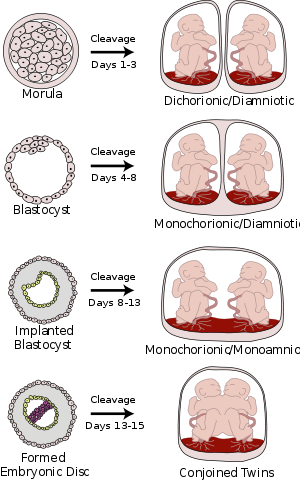
Monochorionic twins
Encyclopedia

TWINS
Two Wide-Angle Imaging Neutral-Atom Spectrometers are a pair of NASA instruments aboard two United States National Reconnaissance Office satellites in Molniya orbits. TWINS was designed to provide stereo images of the Earth's ring current. The first instrument, TWINS-1, was launched aboard USA-184...
that share the same placenta
Placenta
The placenta is an organ that connects the developing fetus to the uterine wall to allow nutrient uptake, waste elimination, and gas exchange via the mother's blood supply. "True" placentas are a defining characteristic of eutherian or "placental" mammals, but are also found in some snakes and...
. If the placenta is shared by more than two twins (see multiple birth
Multiple birth
A multiple birth occurs when more than one fetus is carried to term in a single pregnancy. Different names for multiple births are used, depending on the number of offspring. Common multiples are two and three, known as twins and triplets...
), these are monochorionic multiples. Monochorionic twins occur in 0.3% of all pregnancies. 75% of monozygotic twin pregnancies are monochorionic; the remaining 25% are dichorionic diamniotic. If the placenta divides, this takes place after the third day after fertilization.
Amniocity and zygosity
Monochorionic twins generally have two amniotic sacAmniotic sac
The amniotic sac is the sac in which the fetus develops in amniotes. It is a tough but thin transparent pair of membranes, which hold a developing embryo until shortly before birth. The inner membrane, the amnion, contains the amniotic fluid and the fetus. The outer membrane, the Chorion,...
s (called Monochorionic-Diamniotic "MoDi"), but sometimes, in the case of monoamniotic twins
Monoamniotic twins
Monoamniotic twins are identical twins that share same amniotic sac within their mother’s uterus. Monoamniotic twins are always identical, and always monochorionic as well , and are sometimes termed Monoamniotic-Monochorionic twins. They also share the placenta, but have two separate umbilical cords...
(Monochorionic-Monoamniotic "MoMo"), they also share the same amniotic sac. Monoamniotic twins occur when the split takes place after the ninth day after fertilization. Monoamniotic twins are always monozygotic (identical twins). Monochorionic-Diamniotic twins are almost always monozygotic, with a few exceptions where the blastocysts have fused.
Complications
In addition to a shared placenta, monochorionic twins also have their circulatory systemCirculatory system
The circulatory system is an organ system that passes nutrients , gases, hormones, blood cells, etc...
s intermingled in random and unpredictable circulatory anastomoses. This can cause disproportionate blood supply, resulting in twin-to-twin transfusion syndrome
Twin-to-twin transfusion syndrome
Twin-to-twin transfusion syndrome is a complication of disproportionate blood supply, resulting in high morbidity and mortality. It can affect monochorionic multiples, that is multiple pregnancies where two or more fetuses share a chorion and hence a single placenta...
(TTTS) in 20% of MoDi pregnancies. This is the main complication of monochorionic twins.
The 80% that of MoDi pregnancies without TTTS still have high rates of birth weight discordance, fetal growth restriction, prematurity and resultant cesarean section deliveries. One twin may also fail to develop a proper heart and become dependent on the pumping activity of the other twin's heart, resulting in twin reversed arterial perfusion. If one twin dies in utero, blood accumulates in that twin's body, causing exsanguination
Exsanguination
Exsanguination is the fatal process of hypovolemia , to a degree sufficient enough to cause death. One does not have to lose literally all of one's blood to cause death...
of the remaining twin.
In the case of monochorionic-monoamniotic twins the risk of complications is substantially higher because of additional potential umbilical cord entanglement and compression. However, the perinatal mortality
Perinatal mortality
Perinatal mortality , also perinatal death, refers to the death of a fetus or neonate and is the basis to calculate the perinatal mortality rate. Variations in the precise definition of the perinatal mortality exist specifically concerning the issue of inclusion or exclusion of early fetal and...
of monochorionic twins is fairly low.

